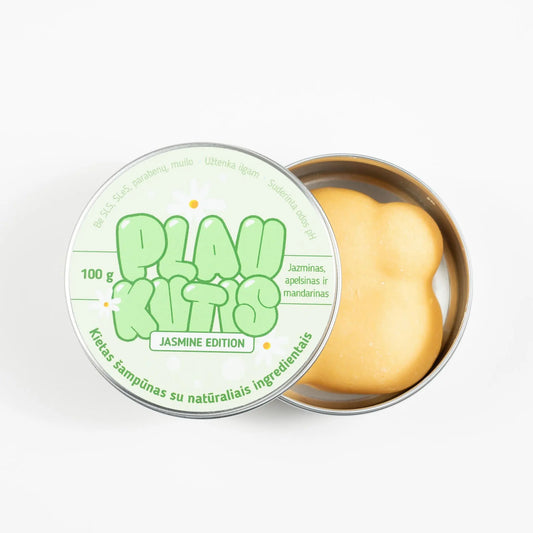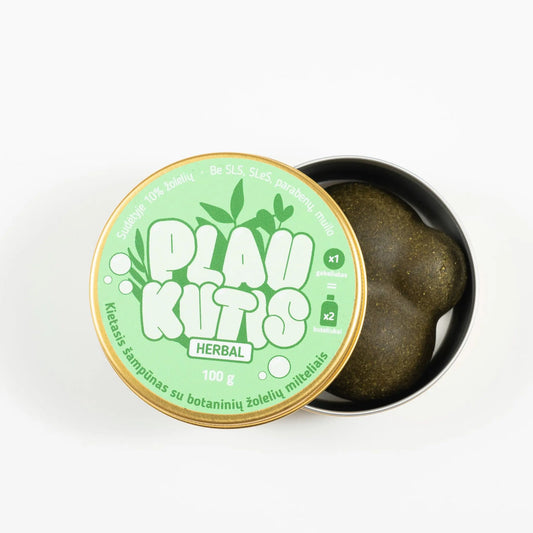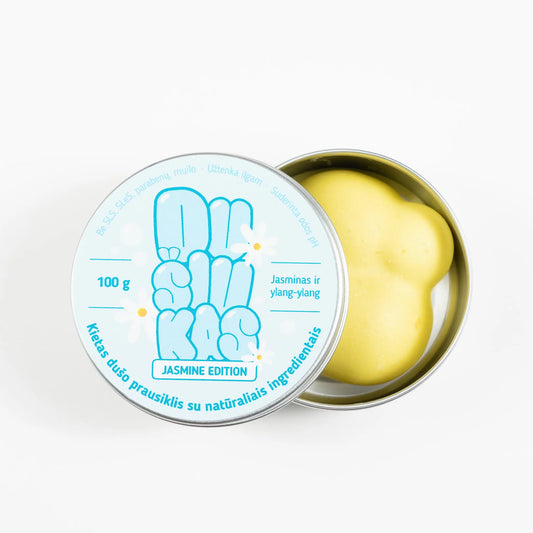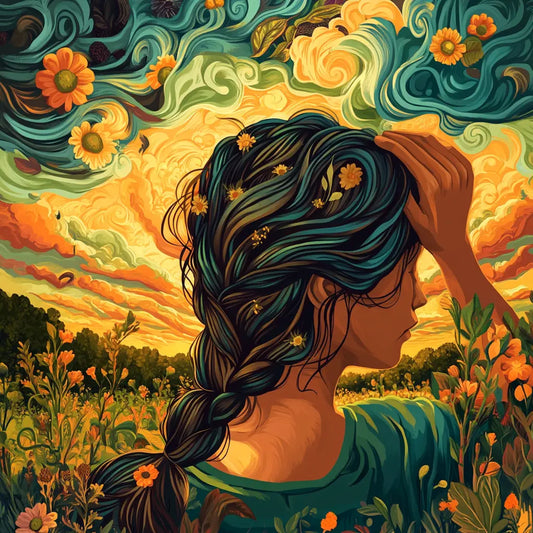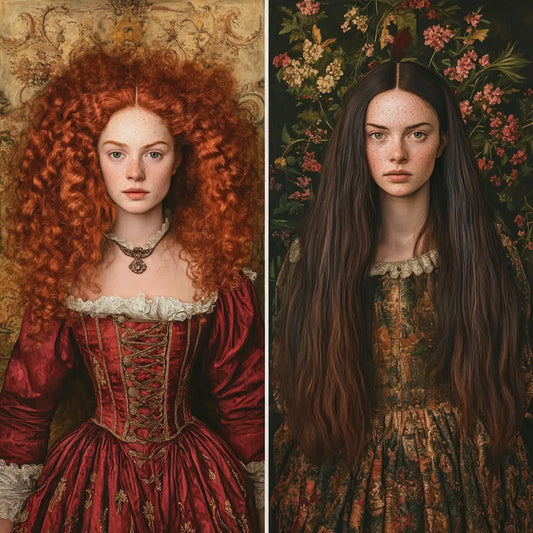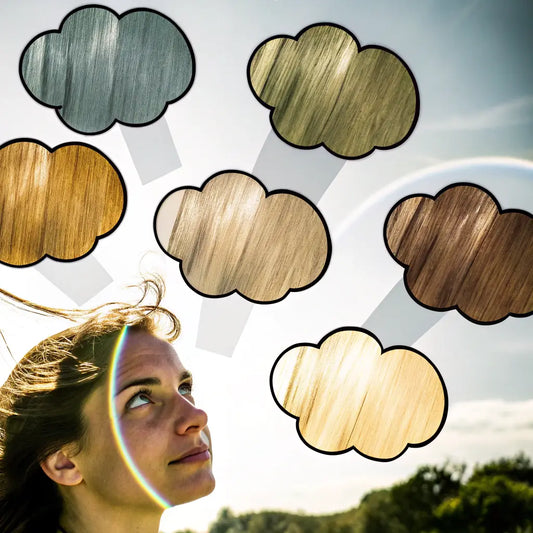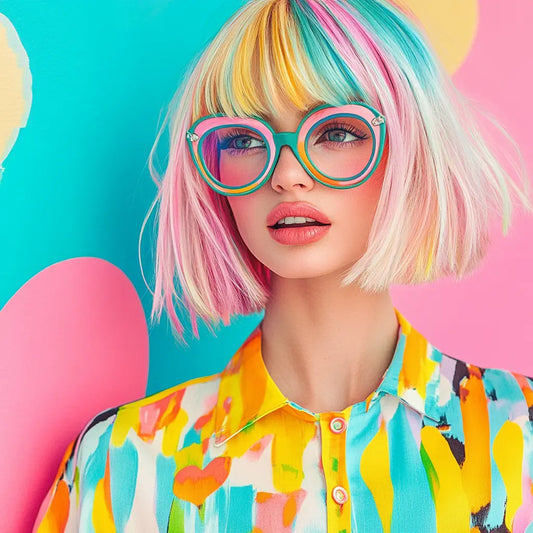1. Hair dye - a guarantee of beauty or a hidden risk?
Coloring your hair is not just a beauty ritual. For many women, it's an emotional habit. A way to regain control, express yourself, or mark a new stage in life.
From a quick at-home dye to a thorough balayage at the salon, changing your color is always a highly personal experience. In fact, a 2023 Statista study shows that over 72% of European women aged 25 to 54 have colored their hair in the past year. Of these , over 35% have done so more than four times a year.
It's no wonder the hair dye market is worth $38 billion worldwide , and shades and styles change as quickly as fashion. But behind all those bright red, chocolate brown, or blonde locks, there's often an important question:
“Is this safe?”
Let's face it - most of us wonder if beauty comes at a cost to our health. You may also be wondering:
-
Can this cause a rash or irritation?
-
Can paint be toxic – is that true?
-
Does this increase the risk of cancer in the long run?
-
Are there gentler alternatives if you love the color but are concerned about your health?
And here's the interesting thing: most of us have never heard a clear, scientifically based answer.
For example, a 2021 review in the Journal of Clinical and Aesthetic Dermatology found that 20–25% of adverse reactions seen in dermatologist clinics were related to hair dye chemicals, specifically PPD (paraphenylenediamine) .

Another cultural example: In India , natural dyes like henna or indigo have been used for centuries, especially during the Karva Chauth or Eid festivals, not only for beauty but also for spiritual purification . However, even “natural” dyes can be dangerous if mixed with metal salts or synthetic additives – something we often don’t think about.
But in Japan , where beauty standards are often associated with naturally black hair, dyeing it was once considered a rebellion. Today , more than 60% of Japanese women between the ages of 20 and 40 dye their hair regularly , showing how much the cultural significance of hair color has changed.
“Hair coloring is one of the most common forms of self-expression we see among women of all ages,” says Dr. Sandra Lee, a board-certified dermatologist. “But the discussion about safety needs to be louder, clearer, and much more honest.”
That is what this article is for.
Together we will find out:
-
What science says about the risks of dyes – from cancer to skin irritation and hormonal effects
-
Expert advice from dermatologists and toxicologists
-
How to choose safer products (and avoid marketing gimmicks)
-
Why hair dye isn't just a cosmetic – it's often emotional support during change
-
How to dye your hair safely during pregnancy
-
And we will answer the most popular questions about the safety of hair dye
So whether you're painting your home or just planning a change, this guide is for you .
Your beauty doesn't have to come at the cost of your health.

2. Risk factors: what science says about the safety of hair dye
2.1 Allergic reactions and skin irritation
Let's start with the most common fear – skin reactions .
The main culprit? The chemical paraphenylenediamine (PPD) . It's found in more than 75% of permanent hair dyes , especially darker shades. PPD ensures long-lasting color vibrancy, but it's also a very common allergen .
The most common symptoms of PPD allergy:
-
Itchy, red, or swollen scalp
-
Burning sensation
-
Blisters or peeling skin
-
Swelling around the eyes and ears
According to a study in the Contact Dermatitis Journal , 0.1–1% of people are allergic to PPD , but repeated use increases the risk.
🔍 Little-known fact: PPD sensitivity can occur after several years of use , even if there were no previous reactions.
How to stay safe:
-
Always do a 48-hour patch test , even if it's your favorite dye.
-
Never apply dye to damaged or irritated skin.
-
If you have had a reaction before, consult a dermatologist for allergy testing.
“We’ve been seeing more delayed allergic reactions after at-home hair color treatments lately,” says Dr. Anika Patel, a dermatologist in the UK. “This isn’t an exaggeration—it’s a way to protect yourself from serious problems.”
2.2 Cancer risk: what the research shows
What about the biggest fear – can hair dye cause cancer?
The answer: complicated. Research is still ongoing, and scientists have mixed opinions.
What we know today:
A study published in The International Journal of Cancer in 2019 followed 117,200 women for 36 years. The results showed:
-
Women who frequently dyed hair had a 9% higher risk of breast cancer
-
Dark colors were linked to risk of Hodgkin lymphoma
-
Black women who dyed their hair every 5-8 weeks had a 60% higher risk of breast cancer than those who did not dye their hair.
However, the American Cancer Society and WHO have not yet confirmed a clear link because:
-
Many paint formulas have changed since the 1970s
-
Research often relies on surveys, which may be inaccurate
🔬 Unexpected study: A 2004 review in Toxicology Letters revealed that hairdressers have a higher risk of bladder cancer due to constant contact with dyes – but this does not necessarily apply to consumers.
How to reduce the risk?
-
Reduce the frequency of permanent dye use
-
Avoid dark shades, which contain more chemical compounds
2.3 Hormone balance and absorption through the scalp
Few people think about it, but the scalp is one of the most absorbent areas of the skin due to good blood circulation and a thin layer of skin.
The question is: can the chemicals in the paint enter the bloodstream?
What is worth looking into:
-
Resorcinol – a potential endocrine disruptor
-
Ammonia – irritates the respiratory tract and damages hair cuticles
-
Parabens and phthalates – used as preservatives, may affect hormone balance
💡 Little-known fact: The European Union has banned more than 1,300 chemicals in cosmetics. The United States has only banned 11. As a result, dyes sold in Europe are often more safely regulated .
“When clients ask about the toxicity of dyes, I tell them it’s like alcohol or sugar: Use in moderation,” says Dr. Eliza Wu, a cosmetic toxicologist. “It’s not just the chemical composition that matters, but also the frequency and amount.”
Unexpected fact: is dark paint more dangerous?
Yes! Manufacturers use higher concentrations of PPD and other chemicals to achieve dark shades. A study by Environmental Health Perspectives found:
-
Dark paints contain 2-4 times more allergens than light paints
-
The risk of allergic reactions and chemical absorption increases by 25-30%
What to do when going for darker shades:
-
Avoid coloring the same hair multiple times (overlapping coloring)
-
Use moisturizers after coloring
-
Extend the painting interval to reduce “chemical build-up”
Short chemical risk table
| Material | What does it do? | Possible risks |
|---|---|---|
| PPD | Ensures long-lasting color | Skin allergy, sensitivity |
| Ammonia | Opens hair cuticles | Irritation, respiratory problems |
| Resorcinol | Promotes color fixation | Hormonal imbalances |
| Parabens | Preservatives | The influence of hormones on the body |
| Phthalates | Odor stabilizers | Reproductive system risks |
| Coal paint | Pigments | Possible carcinogen (banned in the EU) |
The most important conclusion:
Not all hair dyes are dangerous – but some ingredients may have known risks, especially when used frequently or incorrectly.
Below is what dermatologists and toxicologists recommend to ensure safe coloring.

3. What the professionals advise: insights from dermatologists and toxicologists
3.1 Insights from dermatologists and toxicologists
Beauty shouldn't come at the cost of health. Here's what those who know best about the effects of chemical ingredients on our skin and body say.
“Hair dye allergies can occur even after years of safe use,” says Dr. Marisa K. Garshick, a board-certified dermatologist in New York City. “The biggest mistake is to think you’re safe if you’ve never had a reaction before.”
Dr. Garshick often treats women suffering from contact dermatitis , where the skin becomes itchy, flaky, or irritated due to allergens.
“We’re also seeing more women complaining about scalp sensitivity – it’s not always an allergy, sometimes it’s just too much dye,” adds Dr. Shereene Idriss, founder of Idriss Dermatology.
What do toxicologists say?
“Just because it says ‘natural’ on the packaging doesn’t mean the product is safe,” explains Dr. Tina Sayre, a cosmetic toxicologist. “For example, henna is often mixed with metal salts or PPD to make the color brighter—and that’s what causes the most problems.”
All these experts agree on one thing: the safest way to dye your hair is to dye it wisely, not too often.
3.2 How to reduce risk – expert advice
The good news is that you don't have to give up color completely. The key is to dye responsibly , especially if you have sensitive skin or dye frequently.
✅ Advice from dermatologists and toxicologists:
-
Patch test before every dyeing – even if it’s your regular product.
-
Color less often. Avoid full color more often than every 6-8 weeks .
-
Do not apply the dye directly to the scalp. Ask your hairdresser to dye only the lengths of your hair.
-
Use gloves and ventilate the room well. Odors may irritate the respiratory tract.
-
Rinse off the dye in time. Do not exceed the time specified in the instructions.
-
Monitor your skin. If you feel any burning or itching, wash off the dye immediately and consult a doctor.
🟦 Added benefit: 10 safety steps before painting
A quick checklist to always stay safe:
-
Read the full ingredients list. Watch for PPD, ammonia, resorcinol, parabens, phthalates.
-
48-hour patch test – apply a little dye behind your ear and wait for a reaction.
-
Test on a strand of hair – check the color and reaction.
-
Do not wash your hair before coloring. Natural oils protect the scalp.
-
Always wear gloves.
-
Protect your skin with petroleum jelly around your hairline to reduce irritation.
-
Ventilate the room. Open a window or turn on a fan.
-
Avoid dyeing already colored hair. This helps reduce build-up.
-
Rinse with warm, not hot, water. Hot water irritates the skin even more.
-
After coloring – moisturize. Use masks or conditioners.
💡 Additional tip: If you have autoimmune diseases or sensitive skin, consult a dermatologist . Sometimes it is worth choosing a dye recommended by dermatologists, such as Goldwell Elumen, Schwarzkopf Essensity or Oway (Organic Way) .
Summary
Experts don't say "don't do it" - they say "do it smartly" . The best thing to do is to know your scalp, choose products carefully and always follow safety advice.
Below is how often to dye your hair to avoid problems in the long run, and what studies support this.

4. Frequency of use: How much is too much?
Hair coloring is like coffee or red wine. Occasionally, it's a fun embellishment. But often, it can have unexpected consequences.
So how often should you dye your hair to stay healthy? Let's see what science says.
4.1 Safe frequency of dyeing
Most store-bought dyes are not designed for weekly use . The more often you dye, the more chemicals can build up on your scalp and hair .
Dermatologists' recommendations:
-
Permanent dye (full head): no more often than every 6-8 weeks
-
Roots only: every 4-6 weeks
-
Semi-permanent dyes or glosses: every 4-6 weeks
-
Henna or herbal dyes: more often, but be careful – some additives can be dangerous
🟢 Hair porosity is important!
-
High porosity hair (damaged, bleached, curly): absorbs dye faster, but also fades faster – so it requires more maintenance rather than frequent coloring.
-
Low porosity hair (healthy, strong): harder to saturate, so requires longer-lasting dye – but the risk of scalp irritation increases.
💡 Little-known fact: According to the American Academy of Dermatology , frequent coloring can affect the scalp microbiome , causing dryness, dandruff, or itching - especially in women over 40.
4.2 Long-term “cumulative” effect
We often think of hair dye as a short-term solution. But the reality is: chemical stress builds up with every color you use – especially if you've been coloring your hair for decades.
Some long-term studies:
-
A study by the National Institutes of Health (NIH) found that women who dyed their hair every 5-8 weeks for more than 15 years had a 14% higher risk of breast cancer .
-
Hairdressers who worked with dye daily had a slightly higher risk of bladder cancer , but the association was weaker among casual users.
-
Some studies show that dye chemicals remain in the hair structure for months , even after the color fades – meaning that “chemical build-up” lasts longer than you might think.
💬 Expert comment:
"It's not just what you use, it's how many years, how often, how long. It's like sunlight - a single dose doesn't hurt, but over time it builds up," explains Dr. Simone Lambert, a hair toxicologist.
🟩 Expert Tips: A Safe Coloring Schedule
A short table of how often to dye your hair - depending on your hair type and dye:
| Hair type | Paint type | Max. painting | Safe choice alternative |
|---|---|---|---|
| Thin/damaged | Permanent paint | Every 8-12 weeks | Root-only coloring or ammonia-free coloring |
| Curly/wavy | Semi-permanent | Every 4-6 weeks | Toning conditioners |
| Gray/thick hair | Permanent paint | Every 6 weeks | Paints with bonding additives |
| Naturally black | Henna or gloss | Every 4-6 weeks | Pure henna or indigo blends |
| Chemically damaged | Ammonia-free paint | Every 8 weeks | Root pencils or powders between colorings |
Final conclusion
It's not just about whether you dye your hair, but also how often , what you use , and how your skin reacts . Longer intervals between dyeing, protective measures, and smart product choices help maintain both beauty and health.
Next, we'll look at safer coloring alternatives - from ammonia-free formulas to plant-based and biotechnological innovations.

5. Safe Alternatives: How to Choose the Gentlest Path to Color
For many women, coloring their hair is not just about beauty, but also about self-expression. And the good news is that you don't have to give up color if you know how to choose safer alternatives.
Here's your guide from ammonia-free dyes to advanced biotechnology - everything to make color a joy without unnecessary risk.
5.1 Ammonia-free paint: better, but not perfect
Ammonia helps open the hair cuticles so the color can absorb. However, it:
-
Causes burning or itching of the scalp
-
May damage hair structure
-
Irritating to respiratory tract due to strong odor
Ammonia-free dyes use MEA (monoethanolamine) or ethanolamine instead. These are gentler solutions, but they are still synthetic.
“Ammonia-free doesn’t mean it’s chemical-free,” says Dr. Carla Navarro, a dermatologist who specializes in scalp conditions. “Some ammonia substitutes are quite strong alkalis.”
However, they are gentler for sensitive skin or very damaged hair .
Recommended brands:
-
Schwarzkopf Essensity
-
Clairol Natural Instincts
-
Wella Color Touch
5.2 Vegetable and herbal dyes
Henna, indigo, cassia, and chamomile have been favorite dyes for women for thousands of years, especially in India, North Africa, and the Middle East .
What is worth knowing:
-
Henna (Lawsonia inermis) gives a coppery hue and strengthens hair
-
Indigo (Indigofera tinctoria) is used in combination with henna to produce brown or black shades
-
Cassia gives a warm golden hue, especially to blonde hair
-
Chamomile gently lightens blonde hair
⚠️ Warning:
“Natural” henna mixtures are often mixed with PPD or metal salts – especially so-called “black henna.” This is the most dangerous option.
💡 Insider tip:
Look for henna marked “BAQ” (Body Art Quality) – this is the purest option without harmful additives.
Trusted brands:
-
The Henna Guys
-
Khadi Natural
-
Lush Henna Bricks
5.3 “Ecological” and “clean” paints – what is really behind them?
"Clean beauty" is gaining popularity, but it's often just a marketing gimmick.
Key differences:
-
Organic: can mean plant-based ingredients, but not necessarily free of synthetic impurities
-
Clean: has no clear regulation, often just a promotional word
-
Non-toxic: also often used without scientific basis
“Most hair dye manufacturers abuse the term ‘clean beauty.’ If they don’t publish the full ingredients or have independent certification, be careful,” warns Dr. Thomas Renwick, a cosmetic chemist.
What is worth paying attention to:
-
Transparency – clear composition
-
Independent certifications – COSMOS, ECOCERT, USDA Organic
-
Clear promises about what the manufacturer does not use (e.g. PPD-free, paraben-free)
Reliable "clean" paint:
-
Oway (Organic Way) – plant-based, biodynamic oils
-
Natulique – certified organic dyes used in salons
-
Herbatint – popular in Europe, “semi-natural” dye
5.4 Biotechnology: New trends in safe color
The future of hair dye is safer and smarter .
New trends:
🔬 Biotechnological pigments are special dye molecules that are less allergenic and do not damage the hair structure.
🌿 Formulas with bond-strengthening ingredients – Olaplex-type dyes that strengthen hair while coloring.
💧 Tinted conditioners and glosses are gentle, do not penetrate the hair, but only refresh the color.
🧬 Creating pigments from plant stem cells is still an experimental field, but it could change the paint market.
🟨 Unexpected fact: differences in paint safety between the US and EU
Did you know?
-
The EU has banned 1,300+ ingredients in cosmetics
-
USA – only 11
As a result, most paints in Europe must meet much stricter requirements – and American women often buy EU products online to feel safer.
📍 Real example:
Lead acetate (men's "long-lasting" dye) was banned in the EU back in 2007. In the US – only in 2022 !
Summary
Safe hair color doesn't mean boring or disappointing. It means making a conscious choice .
Please observe:
-
Clear ingredient lists
-
Independent certificates
-
Semi-permanent or plant-based alternatives
-
Spacing between painting and additional protective measures
Next, let's look at the positive side : why dyeing your hair can be more than just color - it can be psychological therapy and a sign of strength.

6. The Bright Side: More Than Beauty
Coloring your hair is not just a matter of beauty. It's about self-awareness . The ability to look in the mirror and say, "This is me."
Yes, there are risks. But there are also emotional benefits that shouldn't be overlooked. For many women, a new hair color is a way to regain confidence , mark a new beginning, or simply be more in tune with how we feel inside.
6.1 Self-expression and sense of confidence
Color is a message. And hair color is one of the boldest, clearest messages.
Whether it's a platinum-hued transformation or a soft golden tone, the color says:
-
"I'm starting over."
-
"I'm in control again."
-
"I'm not afraid of being seen."
🧠 Science backs it up. A 2020 study in the journal Psychology of Aesthetics, Creativity, and the Arts showed that women who changed their hair color or cut felt 25% more confident even 2 months after the change.
💬 “When I dyed my hair blue after my divorce, it wasn’t just a change in appearance—it was a statement,” says Sarah M., 36. “It was a way to show that I was still strong.”
6.2 Covering gray hair and accepting change
Speaking of gray hair, for some it's a symbol of wisdom, and for others it's a reminder of the passing of time. And that's completely natural.
For most women, coloring their hair is not a vanity item, but a way to maintain their identity , even as their bodies change.
A 2022 L'Oréal survey showed:
-
67% of women over 40 felt more confident after coloring their gray hair.
-
41% said that getting their color back helped them feel "like themselves."
💡 Interesting fact: In ancient Rome, women used goat fat and beech ash to dye their gray hair. In Victorian England, lead combs were used, which gradually darkened the hair (unfortunately, very dangerous!).
Hair color has always been associated with change – it's a historical ritual .
6.3 Cultural and social significance
In various cultures, hair coloring is not only a matter of beauty, but also a symbol of tradition, freedom, or rebellion .
🔹 In South Korea, students often dye their hair lighter colors after graduating from school - a sign of freedom after strict rules.
🔹 In Iran, despite restrictions, women secretly dye their hair at home - a statement of personal freedom .
🔹 In Latin American cultures, coloring is often considered a symbol of femininity and strength , especially among mothers and grandmothers.
In the West, hair color is also associated with personality stereotypes – fiery redhead, crazy blonde, mysterious brunette. While stereotypes are often exaggerated, they show how deeply hair color affects our image – both how others see us and how we feel about ourselves.
“Hair color is a silent signal of personality, mood, and status,” says Dr. Michelle Hanover, a cultural anthropologist. “For women, it’s often about more than just style, it’s about inner transformation.”
🟪 Emotional Turn: "For the first time, I felt like it was me again"
“After giving birth, I didn’t recognize myself anymore. My body changed, I felt tired and invisible,” says Laura T., 32. “One day I went to the salon and dyed my hair honey. It was the first thing I had done just for myself in a long time. I cried when I looked in the mirror – not because I looked beautiful, but because I finally saw myself again.”
Stories like these are no exception. For many women, dyeing their hair becomes a small step towards self-recovery , especially during a difficult phase of life.
Summary
Hair coloring is not just about beauty. It is:
-
Self-confidence
-
Sense of control
-
Cultural significance
-
A little emotional therapy
Yes, the risks are important. But the emotional impact is also very important.
Next, how to dye your hair during pregnancy to feel safe and relaxed.

7. Special attention: hair coloring during pregnancy
Pregnancy is a time when many questions arise: "Can I do this?" Hair coloring is no exception.
The good news is that most experts agree that coloring your hair during pregnancy is usually safe , if done responsibly.
7.1 Is it safe? What doctors say
Most studies show that infrequent hair coloring during pregnancy is not dangerous , especially if precautions are taken.
Why?
-
Only a small amount of dye enters the body through the skin
-
There is no evidence that hair dye harms fetal development.
-
A greater risk is inhalation of paint fumes , especially in unventilated areas.
“While it’s always a good idea to be cautious, modern hair dyes have no proven link to fetal development,” says Dr. Elaine Chen, an obstetrician-gynecologist at NYU Langone. “It’s just the timing and the way you dye that matters.”
When is the best time to paint?
-
First trimester (weeks 1-12): It's best to avoid coloring. This is a time when your baby's organs are forming and your skin may be more sensitive.
-
Second and third trimesters: considered a safer period, especially if precautions are taken.
7.2 Best choices during pregnancy
If you are planning to dye your hair during pregnancy, here is what doctors recommend:
✔️ What to choose:
-
Strand coloring (highlights, lowlights, balayage) – the dye does not stain the scalp , so less is absorbed into the body
-
Ammonia-free or semi-permanent dyes
-
Professional painting in a salon where good ventilation and hygiene are ensured
🚫 What to avoid:
-
Full hair coloring during the first trimester
-
Strong box dyes with a pungent odor and ingredients of unknown origin
-
Leaving the dye on longer than the instructions indicate
💡 Unexpected fact: A 2021 European study showed that pregnant women who used organic henna or color-refreshing conditioners had no side effects - this is the safest alternative.
🟫 Additional tips at home
Do you want complete security or minimal risk? Here are some ideas:
-
Tinted conditioners or glosses – gentle shade without ammonia
-
Color-refreshing shampoos – help maintain color between colors
-
Root concealer powders – a quick solution for gray hair
-
Mascaras or pencils – temporary, washable with water
“It’s not a good idea to experiment with new products or harsh dyes during pregnancy,” emphasizes Dr. Amita Singh, a women’s health specialist. “Stick with what you’ve been using safely, or choose methods that don’t touch your skin.”
Summary
Dyeing your hair during pregnancy is not taboo, but it is important:
-
Wait until at least the second trimester
-
Choose strand dyeing or vegetable dyes
-
Avoid dye that comes into contact with the scalp and poorly ventilated areas
Now it's time to sum it all up - how to balance beauty, health, and self-confidence.

8. Conclusion: Balance, Knowledge, and Your Beauty
Hair color is more than just a shade. It's your story, your mood, and your confidence .
Throughout this article, we've learned that hair dyes aren't completely harmless, but they're not automatically dangerous either. Like most things, safe coloring is a matter of balance .
What is worth remembering:
-
Watch the ingredients. Know what ingredients to avoid.
-
Don't overdo it. Apply less often - this will protect both your skin and your health.
-
Test before each dyeing. Even if you have been dyeing for years, an allergy can develop unexpectedly.
-
Look for clean alternatives. From plant-based to biotech, there is no shortage of safe choices.
-
Listen to your body. If you are pregnant, have sensitive skin, or have hormonal changes, choose even more carefully.
“Safe beauty is conscious beauty,” reminds Dr. Lina Torres, a cosmetic dermatologist. “When you know what you’re putting on your head, you’re protecting your whole self.”
So paint boldly. Or gently. Or maybe not at all. The most important thing is your decision, your beauty, your safety .
💬 Do you have a story or advice about hair coloring? Share it in the comments - your experience can inspire other women!

9. Myth busting and interesting facts: 5 unexpected things about hair dye
1. Myth: Natural dyes are always safe
✅ Truth:
"Natural" doesn't mean safe. Many "black henna" dye mixtures contain PPD or metal salts that cause allergies .
💬 Did you know?
According to the British Skin Foundation in 2020, "black henna" caused 90% of allergic reactions during summer festivals.
2. Myth: If you use the same dye for a long time, you won't get an allergy
✅ Truth:
Allergies can develop years later , even if there were no problems before.
💡 Interesting fact:
PPD sensitivity can occur a few days later – not immediately after coloring.
3. Myth: Dyeing your hair while breastfeeding is dangerous
✅ Truth:
There is no evidence that hair dye chemicals pass into breast milk. Experts say that it is safe to dye while breastfeeding , especially if you avoid contact of the dye with the scalp.
🍼 Tip: Choose strand coloring or root concealer.
4. Myth: Dyes can permanently damage the brain or hormonal system
✅ Truth:
Hair dye does not reach the brain . Some ingredients can affect hormones, but rarely and only in the case of long-term use .
🧠 Interesting:
The skin absorbs chemicals, but the liver and skin help break them down.
5. Myth: Hair coloring is a modern fashion
✅ Truth:
Hair dyeing has been a part of human life for over 5,000 years ! The Egyptians used lead-based dyes , while the Greeks used a mixture of vinegar and leeks .
🎨 Interesting fact:
Queen Elizabeth I was the first to publicly acknowledge dyeing red hair , creating a fashion in England!
10. Practical tips
✔️ Always do a patch test , even if you are painting with the same paint.
✔️ Avoid dyeing your hair during the first trimester of pregnancy .
✔️ Dark shades contain more chemicals – use with caution.
✔️ Use conditioners and masks after coloring.
✔️ Avoid hot appliances for at least a few days after coloring.

11. FAQ: Frequently Asked Questions About Hair Dye Safety
1. Is hair dye toxic?
Some ingredients (PPD, ammonia, resorcinol) can cause allergies or skin irritation. It all depends on the composition and frequency of use.
2. Can paint cause cancer?
Studies show a small risk , especially with long-term use of dark dyes. But most experts say occasional use is safe .
3. What paints are the safest?
-
Semi-permanent
-
Ammonia-free
-
Herbal (pure henna)
-
Strand dyeing
4. Is it possible to dye your hair during pregnancy?
Yes, especially after the first trimester, using gentle dyes and avoiding scalp contact.
5. Is a patch test needed every time?
Yes! Allergies can develop years later .
6. Is salon dye safer than home dye?
Not always. Salons often use stronger dyes, but professionals know how to apply them properly .
7. How often can I dye?
-
Permanent dye: every 6-8 weeks
-
Root renewal: every 4-6 weeks
8. Does dye affect hormones?
Some ingredients (resorcinol, parabens) can affect hormones, but only with frequent and long-term use.
9. What to do if you have an allergy?
-
Rinse with cool water.
-
Apply aloe vera or cortisone cream
-
Call your doctor if you have difficulty breathing.
10. How to maintain hair health after dyeing?
-
Use sulfate-free shampoos
-
Strengthen your hair with masks
-
Take longer breaks between coloring sessions.
